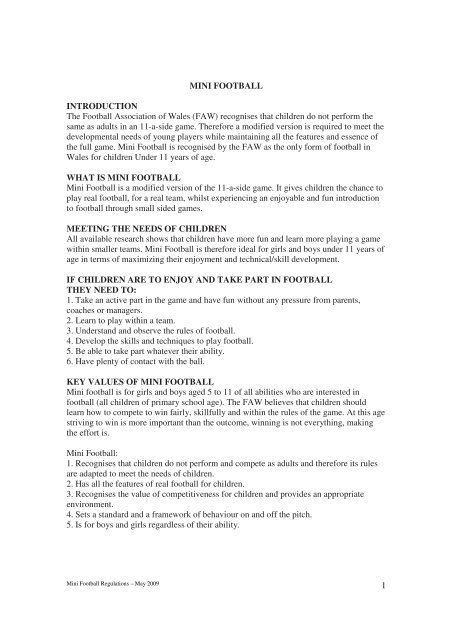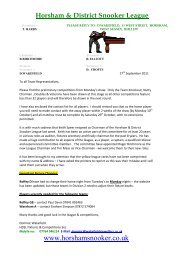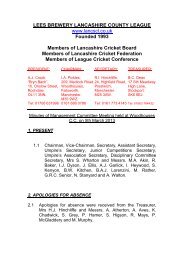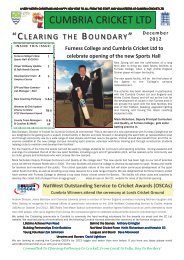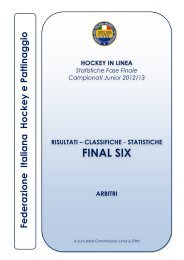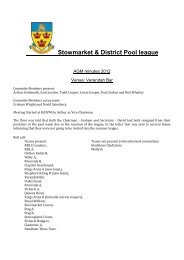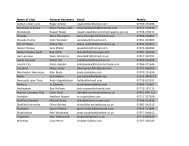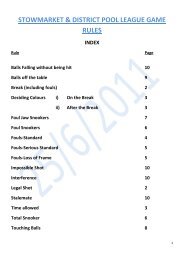Mini Football Regulations - LeagueRepublic
Mini Football Regulations - LeagueRepublic
Mini Football Regulations - LeagueRepublic
- No tags were found...
Create successful ePaper yourself
Turn your PDF publications into a flip-book with our unique Google optimized e-Paper software.
MINI FOOTBALLINTRODUCTIONThe <strong>Football</strong> Association of Wales (FAW) recognises that children do not perform thesame as adults in an 11-a-side game. Therefore a modified version is required to meet thedevelopmental needs of young players while maintaining all the features and essence ofthe full game. <strong>Mini</strong> <strong>Football</strong> is recognised by the FAW as the only form of football inWales for children Under 11 years of age.WHAT IS MINI FOOTBALL<strong>Mini</strong> <strong>Football</strong> is a modified version of the 11-a-side game. It gives children the chance toplay real football, for a real team, whilst experiencing an enjoyable and fun introductionto football through small sided games.MEETING THE NEEDS OF CHILDRENAll available research shows that children have more fun and learn more playing a gamewithin smaller teams. <strong>Mini</strong> <strong>Football</strong> is therefore ideal for girls and boys under 11 years ofage in terms of maximizing their enjoyment and technical/skill development.IF CHILDREN ARE TO ENJOY AND TAKE PART IN FOOTBALLTHEY NEED TO:1. Take an active part in the game and have fun without any pressure from parents,coaches or managers.2. Learn to play within a team.3. Understand and observe the rules of football.4. Develop the skills and techniques to play football.5. Be able to take part whatever their ability.6. Have plenty of contact with the ball.KEY VALUES OF MINI FOOTBALL<strong>Mini</strong> football is for girls and boys aged 5 to 11 of all abilities who are interested infootball (all children of primary school age). The FAW believes that children shouldlearn how to compete to win fairly, skillfully and within the rules of the game. At this agestriving to win is more important than the outcome, winning is not everything, makingthe effort is.<strong>Mini</strong> <strong>Football</strong>:1. Recognises that children do not perform and compete as adults and therefore its rulesare adapted to meet the needs of children.2. Has all the features of real football for children.3. Recognises the value of competitiveness for children and provides an appropriateenvironment.4. Sets a standard and a framework of behaviour on and off the pitch.5. Is for boys and girls regardless of their ability.<strong>Mini</strong> <strong>Football</strong> <strong>Regulations</strong> – May 20091
SKILL DEVELOPMENT1. There is more contact with the ball in <strong>Mini</strong> <strong>Football</strong> leading to a better technique. In11v11 the ratio of ball to outfield players is 1:20, because there are fewer players in <strong>Mini</strong><strong>Football</strong> each player has more regular contact with the ball. More contact with the ballhelps players practice technique and develop technique into a skill through 1v1competition.2. Decision making is easier and occurs more often because of the small numbersinvolved. As a result, the players will gain a greater understanding of the game. The basicfootball situations are easier to see and simpler to solve.3. Because the ball is never far away from the player, the chance of developingconcentration is greatly increased. Playing 11-a-side football, many children lose interestin the game because the ball goes out of their immediate vicinity and they quicklybecome bored spectators.4. Fewer players, more space and simpler decisions will encourage more movement ofplayers whatever the situation.5. More contact leads to more participation and usually, more enjoyment, success iseasier to achieve.MINI FOOTBALL IS THE BASIS OF ALL FOOTBALLSmall sided games have been played for hundreds of years in the street, the playground,or on the beach and many professional teams use them as the basis for their coaching.They invariably lead to basic football situations, such as, 1v1, 2v2 and 3v3 so typical ofthe 11-a-side game. <strong>Mini</strong>-football, through its dynamic tempo, produces more vigorousexercise than 11-a-side football and so helps to improve children’s core components offitness – speed, agility, balance and coordination.ORGANISATION OF MINI FOOTBALLThe general aim of <strong>Mini</strong> <strong>Football</strong> is to provide a safe, supervised environment forchildren to enjoy their introduction to the game.Playing Surface<strong>Mini</strong> football pitches may be specifically laid out on any suitable open spaces orconventional grass or Astroturf football pitches which can be converted for <strong>Mini</strong>-<strong>Football</strong>. There must be no debris or dangerous hazards either on the field of play or inthe immediate surrounding area. Markings must be laid out with the use of conventionallines, marker discs or small cones.Playing EquipmentChildren must wear footwear suitable to the surface being played on. All children mustwear suitable shin guards. All jewellery must be removed.Organisation of games, festivals and fun daysThe FAW believe that the game of <strong>Mini</strong> <strong>Football</strong> provides children with the necessaryintroduction to competition. The game itself is a sufficient skill development challengefor children. As a consequence no league or knockout competition must be organised(or will be sanctioned by the FAW) involving <strong>Mini</strong> <strong>Football</strong>.<strong>Mini</strong> <strong>Football</strong> <strong>Regulations</strong> – May 20092
Matches can be scheduled in a number of different ways to be determined by the JuniorLeague:• On a ‘Home and Away’ basis as determined by the organising junior league.• On a round robin basis where 3 or 4 teams play at one venue against each other,teams can rotate on and off the pitch having rest breaks when not playing.• On a Festival basis where a number of teams play round robin games at a centralvenue. Each team plays against each of the other teams, on completion of the firstround of matches, one team will remain on each pitch while their previousopponents move on to the next pitch. This format is followed until all of the teamshave played against each other, or have played a suitable number of games.Coaches/Managers should ensure suitable breaks are provided between games.‘BEHIND THE LINE, BEHIND THE TEAM’ CAMPAIGNAs part of the FAW/Welsh <strong>Football</strong> Trust’s campaign to improve parent/coach behaviourat <strong>Mini</strong> <strong>Football</strong> matches the use of buffer zones alongside all mini pitches will be pilotedduring the 2009/2010 season. This will be mandatory at all under 7 and under 8matches, a junior league may apply this pilot to the other <strong>Mini</strong> <strong>Football</strong> age groups at itsown discretion. As a consequence at all <strong>Mini</strong> <strong>Football</strong> games clubs MUST:1. Create a ‘Buffer zone’ that runs parallel to pitch, ideally 2 metres from bothtouchlines, a smaller buffer zone can be used where space doesn’t allow 2 metres.2. Buffer zone should be marked by cones or additional marked line.3. Only players, designated coaches and 1st Aider allowed within zone.4. All other spectators must watch from behind the buffer zone lines. NO spectators areallowed to stand on the goal line or behind the goal.<strong>Mini</strong> <strong>Football</strong> <strong>Regulations</strong> – May 20093
THE RULES OF MINI FOOTBALLThe rules are simple and as near to real football as possible. A game leader, who is urgedto be as flexible as possible with the youngest children, supervises the matches.Rules are explained as the game proceeds (for example, hand ball, and then in/out play).It may also be necessary to demonstrate in certain instances how to restart the game (e.g.throw in, corner kicks).1. The game is for boys and girls aged 5 to 11 (as of midnight 31stAugust the previous year) and mixed football is allowed in all age ranges.2. Laws 9 and 10 apply to mini football but there is no off-side. (Refer to FAWHandbook).3. Team size, pitch size and ball size must be implemented as below in the table:ImplementationDateEffective fromstart of 2009/10seasonEffective fromstart of 2009/10seasonEffective fromstart of 2010/11seasonEffective fromstart of 2011/12seasonEffective fromstart of 2011/12seasonAge GroupUnder 7Number ofPlayers4v4No GoalkeepersSize of Pitch Size of Ball(length xwidth)30x20 yards 3Under 85v5Goalkeeperintroduced30x20 yards 3Under 9 6v6 40x30 yards 3Under 10 7v7 60x40 yards 4Under 11 8v8 60x40 yards 44. For Under 9’s, 10’s and Under 11’s they continue to play <strong>Mini</strong> <strong>Football</strong> with thefollowing structure below until the effective season displayed in table above. All other<strong>Mini</strong> <strong>Football</strong> rules apply.Number of Players: Maximum of 8v8Size of Pitch: Maximum of 60x40 yardsSize of Ball: Maximum size 4Size of Goal: Maximum 12 feet x 6 feet.Size of Penalty Area: 10 yards across full width of pitch.5. The maximum goal size for all age groups is 12ft x 6ft. It is highly recommended thatat Under 7 a smaller goal is utilized. This can be achieved through using cones, placing a12ft x 6ft <strong>Mini</strong> Goal face down or using specific smaller goals (such as pop up (pug)goals).<strong>Mini</strong> <strong>Football</strong> <strong>Regulations</strong> – May 20094
6. The goal area can be marked by cones on the touchline and a small number of markerdiscs on the playing area. The goal area extends a set distance from the goal line and isalso a specified width. See table below:Age GroupUnder 7Effective from start of2009/10 seasonUnder 8Effective from start of2009/10 seasonUnder 9Effective from start of2010/11 seasonUnder 10Effective from start of2011/12 seasonUnder 11Effective from start of2011/12 seasonDistance from Goal Line to Width of Penalty AreaEdge of Area (Length)NO Goal AreaNO Goal Area5 yards 10 yards8 yards 15 yards10 yards 20 yards10 yards 20 yards7. A <strong>Mini</strong> Player can only play a maximum of 60 minutes sanctioned match time in one24 hour period. For under 7 and under 8 players this must be broken down into amaximum of either 15 minute individual periods of play or games.8. Any number of substitutes may be used at any time (Rolling substitutes). Players mayre-enter the game and all substitutes must have a period of play. As far as possible thereshould be equal playing time for each player.9. The kick off is taken in the centre of the playing area to start the game and after a goalhas been scored.10. Although Law 15 applies and the throw in should be taken in the normal way, gameleaders can show flexibility.11. Law 17 applies to corner kicks except the opposition should be at least three yardsaway.12. Law 12 applies to free kicks although they are all indirect and the opposition shouldbe at least three yards away.13. Goalkeepers:• Can handle the ball in their penalty area and there are no restrictions on thenumber of steps they may take holding the ball. The Goalkeeper can leave thepenalty area but cannot handle the ball outside the penalty area.• When handling the ball in the penalty area:• Under 7’s, 8’s and 9’s can either throw or kick the ball out of their hands.• While Under 10’s and 11’s can throw the ball out of their hands or kickthe ball on the ground but can then be challenged by opponents.<strong>Mini</strong> <strong>Football</strong> <strong>Regulations</strong> – May 20095
14. Goal-kicks:• Are taken anywhere on the edge of the penalty area – the opposition should be atleast 5 yards away. The ball must be kicked out of the penalty area before anotherplayer touches it.• Under 8’s and 9’s may be taken from their hands from within the goal area.15. There are no restrictions regarding the number of players allowed in the goal areaduring open play.16. Players can pass the ball to their own goalkeeper, for the goalkeeper to handle theball. No pass back rule<strong>Mini</strong> <strong>Football</strong> <strong>Regulations</strong> – May 20096


